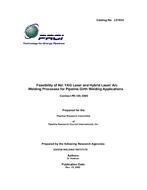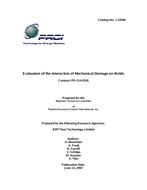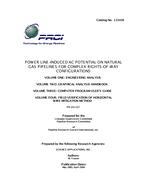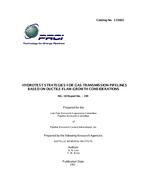Provide PDF Format
PRCI PR-185-0005
- Feasibility of Nd-YAG Laser & Hybrid Laser/Arc Welding Processes for Pipeline Girth Welding Applications
- Report / Survey by Pipeline Research Council International, 12/19/2002
- Publisher: PRCI
$198.00$395.00
L51934e
Edison Welding Institute
Need: The welding of oil and gas pipelines, both on and offshore, is an extremely capital-intensive operation. As a result, the industry is constantly investigating potential productivity enhancements that could dramatically reduce the cost of pipe laying operations. Additionally, welding is extremely critical from a quality standpoint, both in terms of safety and environmental concerns as well as issues related to reduced productivity due to weld rejects. Likely solutions must therefore address both the productivity and quality issues to assure that alternatives to current practices are truly robust enough to provide the desired benefits.
Result: Laser beam welding (LBW) has become standard in many high-production and critical applications where the return on investment can be quickly realized due to the process' inherent efficiency in terms of weld penetration and travel speed. Also, some promising work has been done internationally related to the use of hybrid laser/arc welding (HLAW) for some applications (primarily shipbuilding), so this process variation was also included in the study. However, virtually all of the current LBW or HLAW applications are considered "factory" applications, and therefore do not represent the logistical challenge associated with bringing laser technology to on or offshore pipeline welding operations. This project was aimed at studying the feasibility of overcoming those logistical challenges in order to realize the potential cost savings of applying this high production process. This study was limited to the application of Nd:YAG lasers (which can be delivered via fiber-optic cable) since the logistics of incorporating higher power CO2 lasers was felt to be impractical.
Benefit: The focus of the project was to study the potential productivity of the LBW and HLAW processes in terms of the thickness of material that could be welded in a single pass at a given travel speed. Additionally, the robustness of the process was determined using weld joints with less than ideal fit up. Potential feasibility of the processes were then determined by considering both the practical aspects of their application as well as the economic justification.
Edison Welding Institute
Need: The welding of oil and gas pipelines, both on and offshore, is an extremely capital-intensive operation. As a result, the industry is constantly investigating potential productivity enhancements that could dramatically reduce the cost of pipe laying operations. Additionally, welding is extremely critical from a quality standpoint, both in terms of safety and environmental concerns as well as issues related to reduced productivity due to weld rejects. Likely solutions must therefore address both the productivity and quality issues to assure that alternatives to current practices are truly robust enough to provide the desired benefits.
Result: Laser beam welding (LBW) has become standard in many high-production and critical applications where the return on investment can be quickly realized due to the process' inherent efficiency in terms of weld penetration and travel speed. Also, some promising work has been done internationally related to the use of hybrid laser/arc welding (HLAW) for some applications (primarily shipbuilding), so this process variation was also included in the study. However, virtually all of the current LBW or HLAW applications are considered "factory" applications, and therefore do not represent the logistical challenge associated with bringing laser technology to on or offshore pipeline welding operations. This project was aimed at studying the feasibility of overcoming those logistical challenges in order to realize the potential cost savings of applying this high production process. This study was limited to the application of Nd:YAG lasers (which can be delivered via fiber-optic cable) since the logistics of incorporating higher power CO2 lasers was felt to be impractical.
Benefit: The focus of the project was to study the potential productivity of the LBW and HLAW processes in terms of the thickness of material that could be welded in a single pass at a given travel speed. Additionally, the robustness of the process was determined using weld joints with less than ideal fit up. Potential feasibility of the processes were then determined by considering both the practical aspects of their application as well as the economic justification.
Related Products
PRCI PR-151-127
Power Line-Induced AC Potential on Natural Gas Pipelines for Complex Rights-of-Way Configurations (4..
$748.00 $1,495.00
PRCI Report 194
Hydrotest Strategies for Gas Transmission Pipelines Based on Ductile-Flaw-Growth Considerations..
$498.00 $995.00





